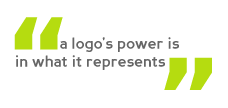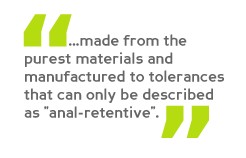Thursday, August 28, 2008
Great Logos
A walk down Main Street or 10 minutes of television  means we're going to encounter logos. A logo is the most obvious and consistent visual representation of a company's brand identity.
means we're going to encounter logos. A logo is the most obvious and consistent visual representation of a company's brand identity.
What is it that makes a great logo?
A great logo has a concept. Logos are symbols that are going to bring an emotional reaction to the person viewing them. When crafting a logo, whether a new one or updating an old one, focus on giving the symbol a conceptual meaning. An excellent example of this is Sprint's "pin-drop" icon. An early campaign boasted such a clear signal that one could hear a pin drop. That idea became a long running campaign. The visual of a pin dropping in their TV spots became the new logo.
Great logos are simple. In your mind, picture some of the most recognizable logos. Apple, Coke, McDonald's, Nike, CBS. All use a simple, clear icon with clean typography. Simplifying the image focuses the viewer on only the most important elements, thereby making what is seen more powerful.
Great logos are timeless Coca-Cola has used the same logo for decades. A logo should be free from trendy and fashionable design elements that can date it once those elements are no longer "in". This has been a issue now more than in the past as graphic designers have harnessed the power of computers and reproduction technology has advanced and changed. The temptation to use all of the available technological tricks in making a logo is strong, but ultimately the results won't last.
In the long run, though, a logo's power is in what it represents. A logo means something to a consumer because they use that symbol to associate an emotion and/or experience with the company. Building a strong brand, one that consistently brings an exceptional experience to the consumer, is the key. Great logos represent great experiences.
Monday, August 25, 2008
The Care & Feeding of Stock Photos in the Wild
The last couple of years has brought a huge number of low-price stock imagery websites to the marketing department's toolbox. If you don't have experience in photo editing or art direction, here are some things to keep in mind to maximize the effects of your images.
- Think conceptually. There are millions of images available that cover some common themes. The CSR with a headset smiling, a team of business people looking at a computer, shaking hands, etc. Make a mental list sometime of all the cliche images you see during the course of a day. Now suppose you're putting together a small tri-fold brochure and you want to show that your company is solutions-oriented. Instead of the engineer working on a computer, how about an image of a swiss army knife, or puzzle pieces. These images will resonate in the readers mind better. People are so bombarded with marketing images that they gloss over things that they have seen many times. There is power in using images to support your text, but only if those images are unique enough to break through the clutter.
- Only use an image if it's going to help. There is a temptation with all this cheap stock to use images just because there is space in the layout.
 Use images like you would use garlic: just the right amount and the food is wonderful, too much and you can't eat it. Sometimes a powerful headline is more effective than an image. For example, can you think of any image that is more powerful than the headline announcing "We've found a cure for cancer"?
Use images like you would use garlic: just the right amount and the food is wonderful, too much and you can't eat it. Sometimes a powerful headline is more effective than an image. For example, can you think of any image that is more powerful than the headline announcing "We've found a cure for cancer"? - Avoid using the images everyone else is. Most stock sites will show how many times an image has been downloaded. If you see one that has a high number of downloads you can bet you're going to see it again, maybe by your competition. Look into those images that haven't been used much. They'll have more impact than something everyone's already seen.
Keep these basics in mind and you're advertising and marketing collateral will be much more effective and influential.
Quality Sucks
“We’re Number One in Quality”, or a variant thereof, is the tagline used by a huge number of business. Count how many times it's used in ads in the Yellow Pages. It’s seen many times emblazoned on the sides of a truck. And it's the wrong thing to say.
Quality has become a generic, meaningless word in business today. You could fill every inch of wall space in a standard office cubicle with Dilbert cartoons about quality. Open the Yellow Pages again and see how many times competing companies use the term. Overuse has robbed it of any true meaning. Quality is an ambiguous, subjective term.  To one consumer, it means that the product still works after a few years, to another it can mean the parts are made from the purest materials and manufactured to tolerances that can only be described as "anal-retentive".
To one consumer, it means that the product still works after a few years, to another it can mean the parts are made from the purest materials and manufactured to tolerances that can only be described as "anal-retentive".
If quality is really one of the factors that separates you from your competitors, use something more specific to describe it. Are you "focused on the tiniest details"? Has your product been "relentlessly tested"? Maybe you're "so efficient, saving customers tons of money on raw materials". Defining what specifically makes you better than your competitors is a subject for another post (or even a book), but it's vitally important to your marketing and advertising being effective.


